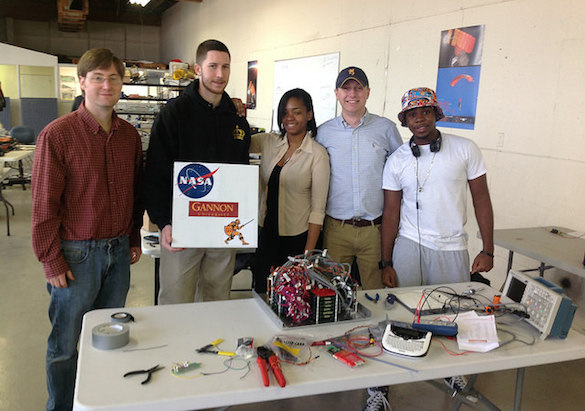Gannon University's Cosmic-Ray Calorimeter (GU-CRC)
PI: Nicholas Conklin, Gannon University
PI: Nicholas Conklin, Gannon University

- TA08 Science Instruments, Observations and Sensor Systems
Cosmic rays are high-energy particles of cosmic origin, primarily consisting of completely ionized hydrogen and helium nuclei. A balloon-born detector to study these particles will be constructed by an interdisciplinary team consisting of faculty and students from the sciences and engineering from Gannon University. The Balloon flight will be used to deploy this payload to an altitude of 120,000 ft. During flight, the payload will collect charge and energy data on incident protons and helium nuclei in the energy range from ~1 to 100 GeV with the aim of measuring the proton-to-helium ratio as a function of energy. This information will provide insight into the acceleration and propagation history of cosmic rays. The payload will also be using a relatively new technology called silicon photomultipliers (SiPMs), which convert light into an electric signal, similar to a traditional photomultiplier tube (PMT), but without requiring high voltage.
The payload is TRL 4 (key functions and basic validation). To achieve TRL 7 software needs to be fully developed and the finished payload needs to successfully operate at balloon-float altitudes.
The payload will be carried to an altitude of 120,000 ft for a flight duration of 6 hours via the Near Space Corporation's Small Balloon System. Flight data will be used to measure the proton-to-helium ratio as a function of energy, which provides insight into the acceleration and propagation history of cosmic rays. Additionally, student participants will gain invaluable hands-on experience, applying knowledge from the classroom to a real-life problem. Students will also develop skills in project management, time management, and team work. Finally, providing students with an opportnity to participate in an interesting science and engineering project will encourage them to continue pursuing careers in these fields, which are of crucial importance to both NASA and the nation.
Technology Details
-
Selection DateUSIP-13 (Aug 2013)
-
Program StatusCompleted
- 1 Balloon
Development Team
-
PINicholas Conklin
-
Organization
-
SponsorNASA Science Mission Directorate
-
More Information

